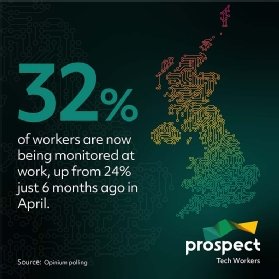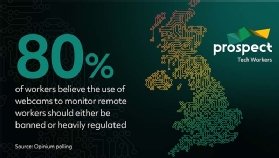
fresnel6 - Fotolia
Watching me, watching you – challenging the rise of digital surveillance at work
Unprecedented levels of digital monitoring at work is embedding a culture of surveillance, despite workers’ opposition to the practices, says Prospect Union
The rise of work-monitoring software is one of the under-reported stories of the pandemic. People analytics, bossware, tattleware, creepy tech – there are a lot of names for it. Surveillance isn’t new, but the rise of monitoring software in response to remote and hybrid working is turning it into a critical question for debates about the future of work.
Microsoft’s latest move into the metaverse promises a fully immersive experience for workers from the factory floor to the meeting room. Another take would be that it could open the door to a level of data-driven management and surveillance we have not yet seen.
The pace of digital change at work is unprecedented, changing not just the jobs we do but also the ways in which we are managed.
Speaking to union members over the past year, we have seen more cases of camera monitoring, location tracking on devices and task allocation software, often introduced with little or no consultation or consideration for how it impacts people’s privacy or well-being. In some cases, data collected for safety purposes is showing up in disciplinary hearings about work performance.
From warehousing and delivery drivers to office workers and skilled professionals working from home, surveillance is becoming part of the new normal at work.
The arguments on digital monitoring go to the heart of power in the workplace, with transparency about the use of data joining pay and terms and conditions as key issues on the table in the bargain between employers and their workforce.
A poll from Prospect Union and Opinium last week revealed how fast this issue is advancing, with one in three workers reporting that they are subject to some form of digital monitoring at work, up from one in four just six months ago.

For remote workers, the change is even more dramatic. Between April and October this year, the proportion of home workers subject to camera monitoring more than doubled from 5% to 13%.
The research also made clear the extent of worker opposition to this technology, finding that 80% of UK workers believed the use of webcams to monitor remote workers should either be banned (52%) or heavily regulated (28%).
Prospect Union argues that government should make it explicitly illegal for employers to use webcams to look into the homes of their employees without their active consent.

In recent years, the world has been waking up to the importance of mass data collection and processing, be that the opportunities it creates such as its potential to revolutionise healthcare, or the risks it poses such as new forms of financial crime.
The development of artificial intelligence (AI) and machine learning (ML) adds another layer to this conversation, as more decisions are capable of being automated if sufficient data exists. In response, governments have sought to regulate the use of data, with the General Data Protection Regulation (GDPR) the stand-out example.
Workers’ rights in a digital world
But while much attention has been given to our rights over our private data as citizens, the conversation over our rights as workers is largely ignored.
This situation is no longer sustainable. The tools that enable mass collection and use of employee data are now widely available to employers, and an increasing number are deploying them.
The 2020 controversy over Microsoft’s “productivity tool” feature, which collected data to establish scores for individual employees, demonstrates the disconnect between the kind of technology that is easily accessible to employers and common perceptions about what is right. Microsoft quickly changed the product after a backlash from campaigners and unions.
Polling by Prospect Union consistently shows that workers are rarely consulted or involved in discussions about the introduction of new technology at work, despite legal obligations for employers to do so in many instances.
Over the past year, Prospect has been training union representatives on how to use their rights under GDPR to ensure unions and workers are involved in discussions over how their data is used by surveillance software. Prospect is arguing that data should be part of collective bargaining arrangements where unions are recognised, as is the case for pay, terms and conditions.
Prospect has been campaigning, alongside tech-minded MPs such as Chi Onwurah, for the Information Commissioner’s Office (ICO) to update its employment practices guidance, on which it has just completed a consultation.
The union has argued – alongside other unions, privacy campaigners and legal experts – that much clearer direction is required to ensure employers are aware of their legal obligations, and the lawful basis in which workers data can be used. Better embedding and enforcing existing legal protections would be a great start, but not the end of this conversation.
As mass data collection and AI become more integrated into business practices, used in everything from recruitment to performance management, we need a thorough reassessment of the legal protections available to workers.
Decisions about our work are some of the most important that affect our lives, so it cannot be right that no clear statement of our rights in relation to this technology exists.
That is why Prospect is arguing that we need an updated statement of workers’ rights in a digital world to keep pace with developments in technology and the behaviour of employers. This could govern everything from the use of algorithms in workplaces, to the appropriate boundaries on surveillance of those who are working remotely.
One thing is clear, we simply can’t continue with a situation where workers are using 20th century rights in response to 21st century technology. It’s time to modernise our data rights and level the playing field on digital technology.
Read more about digital workplace monitoring
- The UK’s Information Commissioner’s Office (ICO) has launched a consultation on the use of personal data by employers, including in workplace monitoring technologies, which will be used to update its existing Employment Practices guidance.
- A UK-based trade union for technology workers and others employed by tech companies is organising around the issue of worker’s privacy and workplace monitoring.
- While software that tracks the activities of staff can be helpful to companies with a remote workforce, managers must consider employees’ concerns and privacy.








